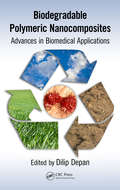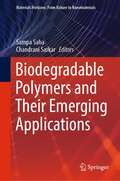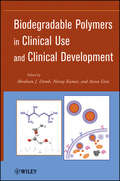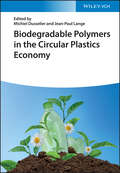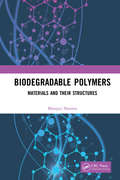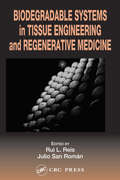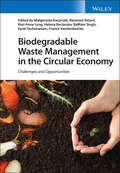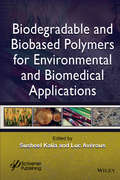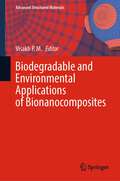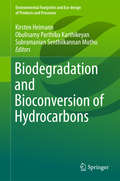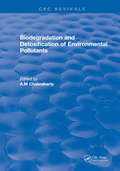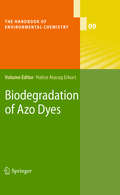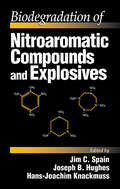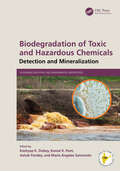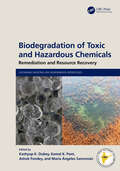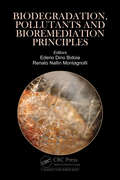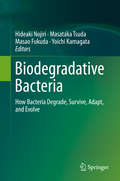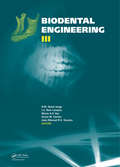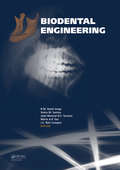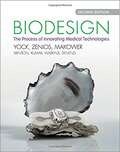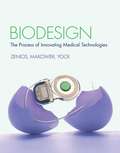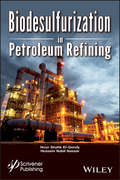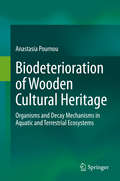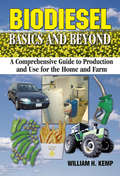- Table View
- List View
Biodegradable Polymeric Nanocomposites: Advances in Biomedical Applications
by Dilip DepanHow Can Polymers Constructed From Living Organisms Help Eliminate the Disposal Issue? A unique category of materials called biodegradable polymers could help remedy a growing environmental concern. Biodegradable Polymeric Nanocomposites: Advances in Biomedical Applications considers the potential of biodegradable polymers for use in biomedical appl
Biodegradable Polymers and Their Emerging Applications (Materials Horizons: From Nature to Nanomaterials)
by Sampa Saha Chandrani SarkarBio-degradable polymers are rapidly emerging as a sustainable alternative to traditional petroleum-based plastics and polymers. However, the synthesis and processing of such polymers present unique challenges and opportunities. In this comprehensive volume, Dr. Saha and her team provide an in-depth exploration of the synthesis and processing of bio-degradable polymers and their emerging applications in various sectors from drug delivery to food packaging. Covering a wide range of topics, including synthesis, modification, processing techniques, and few of their advanced applications in emerging areas, this book provides a comprehensive overview of the field. The authors also delve into cutting-edge research on the synthesis, properties and applications of bio-degradable polymers in various fields, such as agricultural, food preservation, biomedical arena, energy storage and other advanced application areas. This volume is an essential resource for scientists, engineers, and policymakers interested in the future of sustainable materials. Whether you are a researcher looking to expand your knowledge of biodegradable polymer synthesis and processing or a policymaker interested in the potential of biodegradable polymers to reduce our reliance on fossil fuels, this book is an invaluable guide to the field.
Biodegradable Polymers in Clinical Use and Clinical Development
by Abraham J. Domb Neeraj Kumar Aviva EzraThis book focuses on biodegradable polymers that are already in clinical use or under clinical development. Synthetic and natural polymers will be included. This excludes polymers that have been investigated and did not reach clinical development. The purpose of this book is to provide updated status of the polymers that are clinical use and those that are now being developed for clinical use and hopefully will reach the clinic during the next 5 years. The book provides information that of interest to academics and practicing researchers including chemists, biologists and bioengineers and users: physicians, pharmacists.
Biodegradable Polymers in the Circular Plastics Economy
by Michiel Dusselier Jean-Paul LangeBiodegradable Polymers in the Circular Plastics Economy A comprehensive overview of the burgeoning field of biodegradable plastics As the lasting impact of humanity’s reliance on plastics comes into focus, scholars have begun to seek out solutions to plastic litter. In Biodegradable Polymers in the Circular Plastics Economy, an accomplished team of researchers delivers a focused guide (1) to understand plastic degradation and its role in waste hierarchy besides recycling, and (2) to create and use biodegradable plastics where appropriate. Created preferably from renewable resources, these eco-friendly polymers provide an opportunity to create sustainable and lasting solutions to the growing plastic-driven pollution problem. The broad approach to this handbook allows the authors to cover all aspects of these emerging materials, ranging from the problems present in the current plastics cycle, to the differences in type, production, and chemistry available within these systems, to end-of-life via recycling or degradation, and to life-cycle assessments. It also delves into potential commercial and policy issues to be addressed to successfully deploy this technology. Readers will also find: A thorough introduction to biodegradable polymers, focusing not only on the scientific aspects, but also addressing the larger political, commercial, and consumer concerns Mechanisms of biodegradation and the environmental impact of persistent polymers An in-depth discussion of degradable/hydrolysable polyesters, polysaccharides, lignin-based polymers, and vitrimers Management of plastic waste and life cycle assessment of bio-based plastics Biodegradable Polymers in the Circular Plastics Economy is the perfect overview of this complicated but essential research field and will appeal to polymer chemists, environmental chemists, chemical engineers, and bioengineers in academia and industry. The book is intended as a step towards a circular plastics economy that relies heavily on degradable plastics to sustain it.
Biodegradable Polymers: Materials and their Structures
by Manjari SharmaThis book is about development of biodegradable polymers alternatives, which are required to save our reserves of fossil fuels and to save our mother earth from further environmental degradation. This book deals with the family of biodegradable polymers which have to be prepared with a novel idea of studying polymers with a “Cradle to Grave” approach. It touches upon basic materials, which can be potential materials to prepare biodegradable polymers with their basic structures, properties, behaviour and limitations known till date. This book will help students in understanding various characterization techniques which can be used for the study of identification of functional group, structural properties, thermal behaviour, crystallographic nature, mechanical properties and morphological properties through FTIR–ATR for physico chemical properties, DSC & TGA for thermal studies, XRD for crystallographic studies & SEM for morphological studies. It also provides an overview of various testing methods to analysebiodegradability including standard guideline for evaluation of biodegradation and compostability of polymer material through ASTM/ISO/EN standard methods. Note: T&F does not sell or distribute the Hardback in India, Pakistan, Nepal, Bhutan, Bangladesh and Sri Lanka.
Biodegradable Systems in Tissue Engineering and Regenerative Medicine
by Rui L. Reis Julio San RománConventional materials technology has yielded clear improvements in regenerative medicine. Ideally, however, a replacement material should mimic the living tissue mechanically, chemically, biologically and functionally. The use of tissue-engineered products based on novel biodegradable polymeric systems will lead to dramatic improvements in health
Biodegradable Waste Management in the Circular Economy: Challenges and Opportunities
by Malgorzata KacprzakBiodegradable Waste Management in the Circular Economy Presents the major developments in new technologies and strategies for more effective recovery of matter, resources, and energy from biodegradable waste The volume of biodegradable waste produced worldwide is progressively increasing—a trend that is predicted to continue well into the foreseeable future. Developing sustainable, cost-effective, and eco-friendly approaches for processing food waste, agricultural and organic industrial waste, cardboard, biodegradable plastics, sewage sludge, and other types of biodegradable waste is one of the most significant challenges of the coming decades. Biodegradable Waste Management in the Circular Economy provides a detailed overview of the latest advances in the management of biomass for economic development. Featuring contributions from an interdisciplinary team of experts, this comprehensive resource addresses various technologies and strategies for recycling organic matter and many other renewable compounds. In-depth chapters describe the concept of circular economy, identify new sources of biodegradable waste, explore technologies for the production of biodegradable waste end-products, discuss the positive and negative effects of end-products on soil and the environment, and more. Throughout the text, the authors explore systematic approaches for secure biodegradable management in various countries and regions around the world. Explores the social, governance, and economic aspects of “waste as a resource” Addresses metal recovery, biofuel and fertilizer production, and biosorbents and biochar derived from biomass waste Discusses nutrient recovery and energy and bio-methane production from biodegradable waste Covers use cases, collection systems, and regulation of agricultural, industrial, and municipal biodegradable waste streams Presents various technologies for the production of biodegradable waste end-products, including biorefineries, anaerobic digestion, and hybrid methods Reflecting the latest trends in the rapidly changing field, Biodegradable Waste Management in the Circular Economy is essential reading for researchers, engineers, scientists, and consultants working in waste engineering and management, resource recovery, renewable resources, environmental science, agricultural and environmental engineering, soil science, and bioenergy.
Biodegradable and Biobased Polymers for Environmental and Biomedical Applications
by Luc Avérous Susheel KaliaThis volume incorporates 13 contributions from renowned experts from the relevant research fields that are related biodegradable and biobased polymers and their environmental and biomedical applications. Specifically, the book highlights: Developments in polyhydroxyalkanoates applications in agriculture, biodegradable packaging material and biomedical field like drug delivery systems, implants, tissue engineering and scaffolds The synthesis and elaboration of cellulose microfibrils from sisal fibres for high performance engineering applications in various sectors such as the automotive and aerospace industries, or for building and construction The different classes and chemical modifications of tannins Electro-activity and applications of Jatropha latex and seed The synthesis, properties and applications of poly(lactic acid) The synthesis, processing and properties of poly(butylene succinate), its copolymers, composites and nanocomposites The different routes for preparation polymers from vegetable oil and the effects of reinforcement and nano-reinforcement on the physical properties of such biobased polymers The different types of modified drug delivery systems together with the concept of the drug delivery matrix for controlled release of drugs and for antitumor drugs The use of nanocellulose as sustainable adsorbents for the removal of water pollutants mainly heavy metal ions, organic molecules, dyes, oil and CO2 The main extraction techniques, structure, properties and different chemical modifications of lignins Proteins and nucleic acids based biopolymers The role of tamarind seed polysaccharide-based multiple-unit systems in sustained drug release
Biodegradable and Environmental Applications of Bionanocomposites (Advanced Structured Materials #177)
by Visakh P. M.This book provides cutting-edge, up-to-date research findings on the use of bionanocomposites in biodegradable and environmental applications, while also detailing how to achieve bionanocomposites preparation, characteristics, and significant enhancements in physical, chemical, mechanical, thermal properties and applications. This book on biodegradable and environmental properties of bionanocomposites provides a comprehensive and updated review of major innovations in the field of polymer-based bionanocomposites for biodegradable and environmental applications. It covers properties and applications, including the synthesis of polymer-based bionanocomposites from different sources biomaterials-based composites and tactics on the efficacy and major challenges associated with successful scale-up fabrication on bionanocomposites.It is an essential reference for future research in bionanocomposites as topics such as sustainable, biodegradable, and environmental methods for highly innovative and applied materials are current topics of importance. The book covers a wide range of research on bionanocomposite and their biodegradable and environmental applications. Updates on the most relevant polymer-based bionanocomposite and their prodigious potential in the fields of biodegradable and the environment are presented. Leading researchers from industry, academy, government, and private research institutions across the globe contribute to this book. Scientists, engineers, and students with interest in the most important advancements in the field of bionanocomposites involving high-performance bionanocomposites will benefit from this book which is highly application-oriented.
Biodegradation and Bioconversion of Hydrocarbons (Environmental Footprints and Eco-design of Products and Processes)
by Subramanian Senthilkannan Muthu Obulisamy Parthiba Karthikeyan Kirsten HeimannThis book details three main topics: the screening and characterization of hydrocarbons from air, soil and water; technologies in the biodegradation of hydrocarbons; and the bioconversion of hydrocarbons for biofuel/chemicals, as well as recent developments in the remediation of hydrocarbons and their environmental benefits. The first section focuses on screening methods, qualitative and quantitative analysis of hydrocarbons from soil, air and water environments, speciation of hydrocarbons, and natural bioremediation strategies in such environments. The second section examines technologies for removing hydrocarbon contaminants from various environments, especially advanced technologies for the removal of hydrocarbons and in-situ and ex-situ remediation strategies and problems, as well as concrete case studies. The last section, covering the bioconversion of hydrocarbons for biofuel/chemicals, highlights the biochemicals and bioproducts developed from hydrocarbons, with a particular focus on biochemical and chemical technologies used to produce biopolymers, biofuel precursors and commodity chemicals from hydrocarbons.
Biodegradation and Detoxification of Environmental Pollutants
by A.M ChakrabartyThe basic objective of the book is to define and review the recent advances in our understand on the biological mechanisms in the biodegradation and detoxification of various environmental pollutants. The book encompasses recent studies on the mode of detoxication of such mercurial compounds by various microorganisms
Biodegradation and Durability of Materials under the Effect of Microorganisms
by Gennady Zaikov Semenov GumargalievaThis volume in the book series New Concepts in Polymer Science deals with the damaging effects, which microorganisms such as bacteria, fungi, etc. can have on a range of materials in machinery. The book aims to provide theoretical notions about the mechanisms of material damaging by microorganisms under operation conditions as well as to give recom
Biodegradation of Azo Dyes (The Handbook of Environmental Chemistry #9)
by Hatice Atacag ErkurtAzo dyes play an important role as coloring agents in the textile, food, and pharmaceutical industry. Due to the toxicity, mutagenicity and carcinogenicity of azo dyes and their breakdown products, their removal from industrial wastewaters has been an urgent challenge. Promising and cost-effective methods are based on their biodegradation, which is treated in this volume. The topics presented by experts in the field include: the classification of azo dyes; toxicity caused by azo dyes; aerobic and anaerobic azo dye biodegradation mechanisms; the role of bacteria, fungi, algae and their enzymes in biodegradation; the impact of redox mediators on azo dye reduction; the integration of biological with physical and chemical processes; the biotransformation of aromatic amines; reactor modelling for azo dye conversion; the biodegradation of azo dyes by immobilized bacteria and fungi; and factors affecting the complete mineralization of azo dyes.
Biodegradation of Nitroaromatic Compounds and Explosives
by Jim C Joseph B. Hughes Hans-Joachim KnackmussFilled with practical applications and research, Biodegradation of Nitroaromatic Compounds and Explosives presents an international perspective on environmental contamination from explosives. It covers biodegradation strategies for DNT and a wide variety of other nitroaromatic compounds of environmental significance and makes the information access
Biodegradation of Toxic and Hazardous Chemicals: Detection and Mineralization (Sustainable Industrial and Environmental Bioprocesses)
by Ashok Pandey Kashyap K. Dubey Kamal K. Pant María Ángeles SanrománThis reference book discusses the applications of microorganisms as a crucial solution for the sustainable management of toxic pollutants. It describes the microbial remediation of different kinds of pollutants like wastewater, antibiotics, and toxic chemicals. It highlights the technical, scientific, regulatory, safety, and societal impacts of various sustainable biodegradation approaches. The book describes various sensors in environmental pollution monitoring and pollutant detection.KEY FEATURES Provides a deep understanding of the use of sensors in environmental water monitoring and pollutant detection Covers exciting topics like biological upcycling of plastic wastes into value-added chemicals Presents future research needs on biodegradation and scientific challenges in the mitigation of environmental pollutants Brings out the latest themes, such as eco-design study of bio-nanomaterials, bio-nanofilters, and assessment for the treatment of emerging pollutants Reviews the biodegradation of toxicants to improve the quality of water and air and environmental sustainability This book is meant for scientists, ecologists, microbiologists, industry experts, researchers, students, innovators involved in biotechnology research, and policymakers focused on bioremediation.
Biodegradation of Toxic and Hazardous Chemicals: Remediation and Resource Recovery (Sustainable Industrial and Environmental Bioprocesses)
by Ashok Pandey Kashyap K. Dubey Kamal K. Pant María Ángeles SanrománThis timely reference book discusses the biotechnological applications of microorganisms as a crucial solution for the sustainable management of different types of toxic pollutants. It reviews the sustainable biodegradation approach and resource recovery for different kinds of pollutants like plastic wastes, pharmaceutical wastes, pesticides, and textile industry wastes. The book provides an understanding of biotechnology-based interventions toward a zero-waste route. KEY FEATURES Provides a deep understanding of biodegradation of toxic pollutants from industries ranging from textiles to pharmaceuticals Presents novel technologies for the sustainable treatment of environmental pollution Reviews crucial considerations like energy requirements and cost analysis Brings out the latest themes such as the eco-design study of bio-nanomaterials, bio-nanofilters, and assessment for the treatment of emerging pollutants and IoT-based technology Covers the latest research developments in the biodegradation of antibiotics, pesticides, and electronic wastes This book is meant for scientists, ecologists, microbiologists, industry experts, researchers, students, innovators involved in biotechnology research, and policymakers focused on bioremediation.
Biodegradation, Pollutants and Bioremediation Principles
by Ederio Dino BidoiaThis book presents a broad compendium of biodegradation research and discussions on the most up-to-date bioremediation strategies. The most relevant microbiological, biochemical and genetic concepts are presented alongside the fundamentals of bioremediation. The topics include: a wide variety of contaminant impacts evaluation, key methodologies required to measure biodegradation and propose new bioremediation protocols, as well as the handling of microbial communities related to such processes. The selected collaborating authors are renowned for their microbiology expertise and will provide an in-depth reference for students and specialists. The contents provide a valuable source of information for researchers, professionals, and policy makers alike.
Biodegradative Bacteria: How Bacteria Degrade, Survive, Adapt, and Evolve
by Hideaki Nojiri Masataka Tsuda Masao Fukuda Yoichi KamagataBiodegradative Bacteria highlights the novel nature of bacterial cell functions in the field of biodegradation by putting them into three parts: (1) Genetic and genomic systems, (2) Degradative enzyme systems, and (3) Bacterial behavior in natural environmental systems. The first part of the book includes cell functions as degradative machinery, genome systems for effective degradation, and the evolution of degradative systems by mobile genetic elements. The second part deals with the structure, function, evolution, diversity, and application of degradative and related enzymes. The third part presents cell or genomic behaviors of biodegradative bacteria in natural ecosystems. Bacterial metabolic capacity, which plays an important role in the global material cycle, contributes significantly to the buffering capacity for the huge and unintended release of various chemicals. Recently, however, the prosperity and globalization of material civilization has led not only to severe local contamination by hazardous chemicals, but also to continuous increment of contaminant concentrations worldwide. To solve such urgent global issues, bacterial functions that are involved in biodegradation of hazardous chemicals have been analyzed. The term "biodegradative bacteria" refers to those bacteria that have the ability to degrade such xenobiotic (man-made) and/or hazardous chemicals. Analyses of biodegradative bacteria include diverse areas of study, such as genetics, enzymology, genomics, cell physiology, ecology, and evolutionary biology. In other words, the targets investigated in research on biodegradative bacteria include single molecules, single cell systems, bacterial consortia (interaction with surrounding microorganisms), and interaction with surrounding biotic and abiotic materials. Such complexity makes the research on biodegradative bacteria difficult but quite interesting.
Biodental Engineering III
by R.M. Natal Jorge J.C. Reis Campos Mário A.P. Vaz Sónia M. Santos João Manuel R. S. TavaresDentistry is a branch of medicine with its own peculiarities and very diverse areas of action, which means that it can be considered as an interdisciplinary field. Currently the use of new techniques and technologies receives much attention. Biodental Engineering III contains contributions from 13 countries, which were presented at BIODENTAL 2014,
Biodental Engineering: Proceedings Of The 5th International Conference On Biodental Engineering (biodental 2018), June 22-23, 2018, Porto, Portugal
by R.M. Natal Jorge J.C. Reis Campos Sónia M. Santos João Mánuel R.S. Tavares A. P. VazThe aim of Biodental Engineering is to solidify knowledge of bioengineering applied to dentistry. Dentistry is a branch of medicine with its own peculiarities and very diverse areas of action, and in recent years multiple new techniques and technologies have been introduced.This book is a collection of keynote lectures and full papers from Bio
Biodesign: The Process of Innovating Medical Technologies
by Uday N. Kumar Thomas M. Krummel Stefanos Zenios Josh Makower Lyn Denend Todd J. Brinton Paul G. Yock F. T. Jay Watkins Christine Q. KuriharaThis step-by-step guide to medical technology innovation, now in full color, has been rewritten to reflect recent trends of industry globalization and value-conscious healthcare. Written by a team of medical, engineering, and business experts, the authors provide a comprehensive resource that leads students, researchers, and entrepreneurs through a proven process for the identification, invention, and implementation of new solutions. Case studies on innovative products from around the world, successes and failures, practical advice, and end-of-chapter 'Getting Started' sections encourage readers to learn from real projects and apply important lessons to their own work. A wealth of additional material supports the book, including a collection of nearly one hundred videos created for the second edition, active links to external websites, supplementary appendices, and timely updates on the companion website at ebiodesign.org. Readers can access this material quickly, easily, and at the most relevant point in the text from within the ebook.
Biodesign: The Process of Innovating Medical Technologies
by Uday N. Kumar Thomas M. Krummel Paul Yock Stefanos Zenios Josh Makower Lyn Denend Todd J. BrintonRecognize market opportunities, master the design process, and develop business acumen with this 'how-to' guide to medical technology innovation. A three-step, proven approach to the biodesign innovation process - identify, invent, implement - provides a practical formula for innovation. The experiences of hundreds of innovators and companies, in the form of case studies, quotes and practical advice, offer a realistic, action-orientated roadmap for successful biodesign innovation. Real-world examples, end-of-chapter projects, and Getting Started sections guide the reader through each of the key stages of the process and provide a template to create their own new medical devices. Addressing common medical, engineering, and business challenges to develop well-rounded expertise, this book is the complete package for any biodesign entrepreneur. The text is supported by valuable resources, including up-to-date industry changes: found at ebiodesign.org.
Biodesulfurization in Petroleum Refining
by Nour Shafik El-Gendy Hussein Mohamed NassarPetroleum refining and process engineering is constantly changing. No new refineries are being built, but companies all over the world are still expanding or re-purposing huge percentages of their refineries every year, year after year. Rather than building entirely new plants, companies are spending billions of dollars in the research and development of new processes that can save time and money by being more efficient and environmentally safer. Biodesulfurization is one of those processes, and nowhere else it is covered more thoroughly or with more up-to-date research of the new advances than in this new volume from Wiley-Scrivener. <p><p> Crude oil consists of hydrocarbons, along with other minerals and trace elements. Sulfur is the most abundant element after carbon and hydrogen, then comes after it nitrogen, and they usually concentrated in the higher boiling fractions of the crude oil. The presence of sulfur compounds causes the corrosion of refining facilities and catalysts poisoning. Moreover, the presence of nitrogen-compounds directly impacts the refining processes via; poisoning the cracking catalysts and inhibiting the hydrodesulfurization catalysts. In addition, both have bad impacts on the environment, throughout the sulfur and nitrogen oxide emissions. Removing this sulfur and nitrogen from the refining process protects equipment and the environment and creates a more efficient and cost-effective process. <p> Besides the obvious benefits to biodesulfurization, there are new regulations in place within the industry with which companies will, over the next decade or longer, spend literally tens, if not hundreds, of billions of dollars to comply. Whether for the veteran engineer needing to update his or her library, the beginning engineer just learning about biodesulfurization, or even the student in a chemical engineering class, this outstanding new volume is a must-have. Especially it covers also the bioupgrading of crude oil and its fractions, biodenitrogenation technology and application of nanotechnology on both bio-desulfurization and denitrogenation technologies.
Biodeterioration of Wooden Cultural Heritage: Organisms and Decay Mechanisms in Aquatic and Terrestrial Ecosystems
by Anastasia PournouSince prehistoric times and throughout the course of human evolution, wood has been an integral part of all civilizations. Wooden Cultural Heritage can be found worldwide, providing valuable information on the social and economic context of human history. Nonetheless, as a natural cellulosic material, wood shows low resistance to biodeterioration and thus wooden Cultural Heritage often fails to escape decomposition in both aquatic and terrestrial ecosystems. This book provides a comprehensive overview on the biodeterioration of wooden Cultural Heritage and describes the decay mechanisms of key organisms and microorganisms encountered in aquatic and terrestrial ecosystems. Cultural Heritage professionals, researchers and academics may explore within this book the associations between deteriogens, habitats and decay, which will assist them to understand wood biodeterioration and design effective prevention, mitigation and remediation strategies. The book presents case studies around the world to demonstrate the impact of biogenic deterioration on wooden Cultural Heritage and illustrates mechanisms and patterns in order to be a useful handbook of decay diagnosis.Lastly, by adopting a holistic approach to wood decay, basic concepts of wood technology, ecology, and deteriogens' biology are introduced, permitting readers of different scientific backgrounds to easily comprehend wood biodeterioration.
Biodiesel Basics and Beyond
by William H. KempBiodiesel Basics and Beyond aims to separate fact from fiction and to educate potential home, farm, and cooperative manufacturers on the economic production of quality biodiesel from both waste and virgin oil feedstock. The book includes: detailed processes and equipment required to produce biodiesel fuel that meets North American standards how farmers can use excess oilseed as a feedstock for biodiesel production the use of the co-byproduct glycerin in the making of soap a guide to numerous reference materials and a list of supplier data This is North America's definitive guide to responsibly producing biodiesel from waste vegetable oil while minimizing your environmental footprint in the process.
